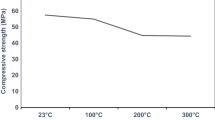Abstract
Engineered Cement Composite (ECC) materials have the potential to be used in applications where a level of pseudo-ductility under tensile stress is required. Most previous work has focussed on comparatively thin specimens. For future civil engineering applications, however, it is imperative that the behaviour of thicker specimens is understood. In the present work, specimens containing cement powder, water, polymeric fibres and admixtures were manufactured following two different processes and tested in tension. Multiple matrix cracking was observed during tensile testing, leading to a pseudo-ductile behaviour. Complementary measurements of sample density and porosity suggest that a high porosity could be linked with an enhanced tensile strain-to-failure whereas high density is associated with a high maximum stress. The fibre dispersion, assessed by scanning electron microscopy, indicated that mechanical performance was enhanced with increasing proportion of fibres aligned along the tensile test axis, and this orientation can be linked to the manufacturing process.













Similar content being viewed by others

References
Li VC (2003) On engineered cementitious composites (ECC)—a review of the material and its applications. J Adv Concr Technol 1(3):215–230
Li VC (2002) Advances in ECC research. ACI Spec Publ Concr 206:373–400. (appears in collection: Civil & Environmental Engineering (CEE))
Li VC, Weiman MB (2003) Hygral behaviour of Engineered Cementitious Composites (ECC). Int J Restor Build Monum 9(5):513–534
Li VC, Wang S, Cynthia Wu (2001) Tensile strain-hardening behaviour of polyvinyl alcohol engineered cementitious composite (PVA-ECC). ACI Mater J 98(6):483–492
Concrete Society (2007) Guidance for the design of steel-fibre-reinforced concrete—Technical Report No. 63, ISBN 1 904482 32 5
Concrete Society (2007) Guidance on the use of macro-synthetic-fibre-reinforced concrete—Technical Report No. 65, ISBN 1 904482 34 1
Van Zijl GPAG (2005) Optimisation of the composition and fabrication methods, applications for precast concrete members, highly ductile concrete with short fibre—Hochductile Betone mit Kurzfaserbewehrung—Entwicklung Pruefung, Anwendung, ed. V. Mechtcherine: 37–54
Van Zijl GPAG, Wittman FH, Oh BH, Kabele P, Toledo Filho RD, Fairbairn EMR, Slowik V, Ogawa A, Hoshiro H, Mechtcherine V, Altmann F, Lepech MD (2012) Durability of strain-hardening cement-based composites (SHCC). J Mater Struct. 45(10):1447–1463
Wang S, Li VC (2004) Tailoring of pre-existing flaws in ECC matrix for saturated strain hardening, Proceedings of FRAMCOS-5: 1005–1012
Japanese Society of Civil Engineers (2008) Recommendations for design and construction of high performance fibre reinforced cement composites with multiple fine cracks (HPFRCC), Concrete Engineering Series. The Japanese Society of Civil Engineers, Japan
Kim J-K, Kim J-S, Ha GJ, Kim YY (2007) Tensile and fibre dispersion performance of ECC (engineered cementitious composites) produced with ground granulated blast furnace slag. Cem Concr Res 37:1096–1105
Kanakubo T (2006) Tensile characteristics evaluation method for ductile fibre-reinforced cementitious composites. J Adv Concr Technol. 4(1):3–17
Neville AM (2000) Properties of Concrete, Fourth and Final Edition. Pearson Education Limited, England
British Standard Institution (1999) BS EN 1015-3: 1999 Method of test for mortar for masonry—Part 3: Determination of consistence of fresh mortar (by flow table). BSI, London
Takashima H, Miyagai K, Hashida T, Li VC (2003) A design approach for the mechanical properties of polypropylene discontinuous fibre reinforced cementitious composites by extrusion molding. Eng Fract Mech 70:853–870
Li VC, Wu C, Wang S, Ogawa A, Saito T (2002) Interface tailoring for strain-hardening Polyvinyl-Alcohol-Engineered Cementitious Composite (PVA-ECC). ACI Mater J 99(5):463–472
Li VC (2002) Reflections on the research and development of engineered cementitious composites (ECC), Proceedings of the JCI International Workshop on Ductile Fibre Reinforced Cementitious Composites (DRFCC)—Application and Evaluation
Redon C, Li VC, ASCE F, Wu C, Hoshiro H, Saito T, Ogawa A (2001) Measuring and modifying Interface properties of PVA fibres in ECC Matrix. J Mater Civ Eng 13(6):399–406
British Standard Institution (2009) BS EN 12390-7: 2009 Testing hardened concrete—Part 7: Density of hardened concrete. BSI, London
Md Safiuddin, Hearn N (2005) Comparison of ASTM saturation techniques for measuring the permeable porosity of concrete. Cem Concr Res 35:1008–1013
Lee BY, Kim JK, Kim JS, Kim YY (2009) Quantitative evaluation technique of Polyvinyl Alcohol (PVA) fibre dispersion in engineered cementitious composites. Cem Concr Compos 31:408–417
Kjellsen KO, Monsoy A, Isachsen K, Detwiler RJ (2003) Preparation of flat-polished specimens for SEM-backscattered electron imaging and X-ray microanalysis—importance of epoxy impregnation. Cem Concr Res 33:611–616
Kaddour AS, Hinton MJ, Smith PA, Li S (2013) A comparison between the predictive capability of matrix cracking, damage and failure criteria for fibre reinforced composite laminates: Part A of the third world-wide failure exercise. J Compos Mater 47:2749–2779
Li VC, Leung CKY (1992) Steady-state and multiple cracking of short random fibre composites. J Eng Mech 118:2246–2264
Cox HL (1952) The elasticity and strength of paper and other fibrous material. Br J Appl Phys 3:72–79
Krenchel H (1964) Fibre reinforcement. Akademisk Forlag, Copenhagen
Acknowledgement
The authors would like to acknowledge funding for this research from the EPSRC (through the MiNMaT Industrial Doctoral Centre, University of Surrey, EPSRC Grant No. EP/G037388/1) and Morgan Sindall Underground Professional Services Ltd. The help of our colleagues, Mr David Fisher, Mr Daniel North and Mr David Renard of Morgan Sindall; and Mr Chris Burt, Mr Peter Haynes and Mr Nigel Mobbs from the University of Surrey, is much appreciated.
Author information
Authors and Affiliations
Corresponding author
Rights and permissions
About this article
Cite this article
Boughanem, S., Jesson, D.A., Mulheron, M.J. et al. Tensile characterisation of thick sections of Engineered Cement Composite (ECC) materials. J Mater Sci 50, 882–897 (2015). https://doi.org/10.1007/s10853-014-8649-6
Received:
Accepted:
Published:
Issue Date:
DOI: https://doi.org/10.1007/s10853-014-8649-6


